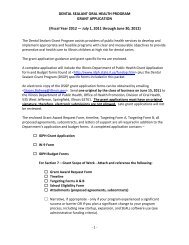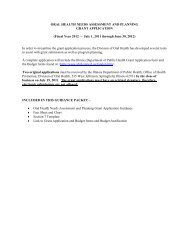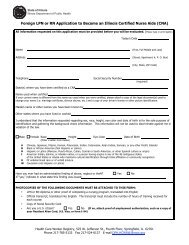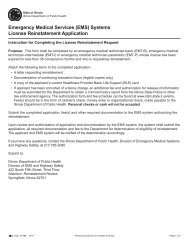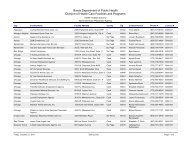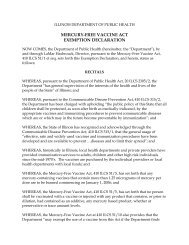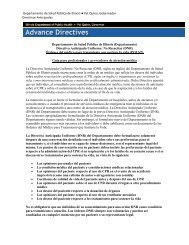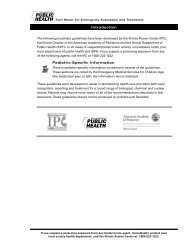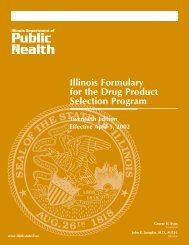Video Relay Service (VRS) - Illinois Department of Public Health
Video Relay Service (VRS) - Illinois Department of Public Health
Video Relay Service (VRS) - Illinois Department of Public Health
You also want an ePaper? Increase the reach of your titles
YUMPU automatically turns print PDFs into web optimized ePapers that Google loves.
<strong>Video</strong> <strong>Relay</strong> <strong>Service</strong> (<strong>VRS</strong>)<br />
What is the video relay service (<strong>VRS</strong>)?<br />
<strong>VRS</strong> is a telecommunication service for Deaf and hard-<strong>of</strong>-hearing individuals who use sign<br />
language as their primary language. <strong>VRS</strong> enables anyone to conduct video relay calls through a<br />
certified sign language interpreter via a computer with high-speed Internet connection and a<br />
webcam or a videophone and a TV. The Deaf user sees an interpreter on their screen and signs<br />
to the interpreter, who then places a call to a hearing person via a standard phone line and relays<br />
the conversation between both parties. Communication using <strong>VRS</strong> is instantaneous and natural.<br />
It can be a useful tool for health care providers to communicate with their patients who use sign<br />
language.<br />
How can health care providers use <strong>VRS</strong>?<br />
To use <strong>VRS</strong>, the health care provider calls a number provided by the patient and talks to the<br />
patient through a sign language interpreter by phone. The sign language interpreter<br />
communicates with the patient in sign language through a webcam. When they have finished<br />
their conversation, they simply hang up.<br />
Step #1: Hearing person<br />
speaks through<br />
interpreter to Deaf or<br />
hard <strong>of</strong> hearing person<br />
who uses sign language.<br />
Step #2: Sign<br />
language<br />
interpreter signs<br />
what the caller<br />
says.<br />
Step #3: Person who<br />
uses sign language sees<br />
message then signs<br />
reply back to sign<br />
language interpreter.<br />
Step #5: Hearing person<br />
listens and then goes<br />
back to Step #1.<br />
Step #4: Sign language<br />
interpreter speaks what<br />
the Deaf person said to<br />
the hearing person. (Or<br />
person can speak<br />
directly to the caller).<br />
Some Deaf people can speak for themselves but use the interpreter to interpret what the person<br />
on the other end <strong>of</strong> the line is saying because they cannot hear well enough to understand what<br />
they are saying. This is called a voice carry over call.
How do people who are Deaf prefer to communicate?<br />
Sign language is considered the “native” language <strong>of</strong> people who are Deaf, and it is more natural<br />
for them to communicate in sign language than in writing (such as through TTY or e-mail).<br />
Also, communicating with the health care provider in their own language through the <strong>VRS</strong><br />
allows more independence for the patient and gives them the ability to make their own medical<br />
decisions rather than having the information conveyed through a family member.<br />
Why should a health care provider use <strong>VRS</strong>?<br />
<strong>VRS</strong> is an efficient and low-cost alternative to TTY or TDD (Teletypewriter, or<br />
Telecommunication Device for the Deaf), e-mail, or communicating through a family member.<br />
<strong>VRS</strong> is available 24 hours a day, seven days a week. <strong>VRS</strong> is accessible and widely used by the<br />
Deaf population.<br />
What equipment is needed to place a <strong>VRS</strong> call?<br />
There is no special equipment needed by the health care provider’s <strong>of</strong>fice (as opposed to the<br />
TTY system, which requires a special TTY phone). Therefore, there is no extra cost to the health<br />
provider other than regular charges associated with calls.<br />
What about privacy/confidentiality?<br />
Confidentiality is an important health care issue, and patients/providers may be worried that<br />
privacy is being violated by talking through a third party. Accommodation services are covered<br />
by the <strong>Health</strong> Insurance Portability and Accountability Act (HIPAA), so confidentiality is<br />
protected. Interpreters have been trained to abide by the Registry <strong>of</strong> Interpreters for the<br />
Deaf/National Association <strong>of</strong> the Deaf Code <strong>of</strong> Ethics and the Federal Communication<br />
Commission’s regulations regarding consumer rights to privacy and confidentiality. Interpreters<br />
also are monitored for compliance toward the <strong>VRS</strong> provider’s policy <strong>of</strong> confidentiality. With<br />
these precautions taken, video relay service may be even more private and secure than e-mail.<br />
What if the person does not answer?<br />
Many <strong>VRS</strong> companies <strong>of</strong>fer “signmail,” which allows the interpreter to leave a<br />
message in sign language for the person via a webcam to retrieve just as a hearing<br />
person would retrieve voice mail.<br />
Is there any certain etiquette involved in using this service?<br />
Do not use “tell him/her....” or “will he/she...?” This etiquette is inappropriate for a conversation.<br />
This is a regular conversation in a different way. Approach the conversation as you would with a<br />
family member, close friend, or any other type <strong>of</strong> conversation. It is polite to identify yourself at<br />
the beginning <strong>of</strong> the call, but not required. <strong>Relay</strong> agents are not permitted to engage in<br />
conversations unless it is for specific call processing reasons (i.e. requesting a number to dial,<br />
providing status on a call, etc.).<br />
This information sheet is prepared by the <strong>Illinois</strong> <strong>Department</strong> <strong>of</strong> <strong>Public</strong> <strong>Health</strong>’s Disability and <strong>Health</strong> Program with a goal <strong>of</strong><br />
promoting health and preventing secondary conditions among citizens with disabilities. Funding is provided by the U.S. Centers<br />
for Disease Control and Prevention through a cooperative agreement. To learn more about the program and how to become<br />
involved, call 217‐782‐3300 or TTY 800‐547‐0466.<br />
PRINTED BY AUTHORITY OF THE STATE OF ILLINOIS




